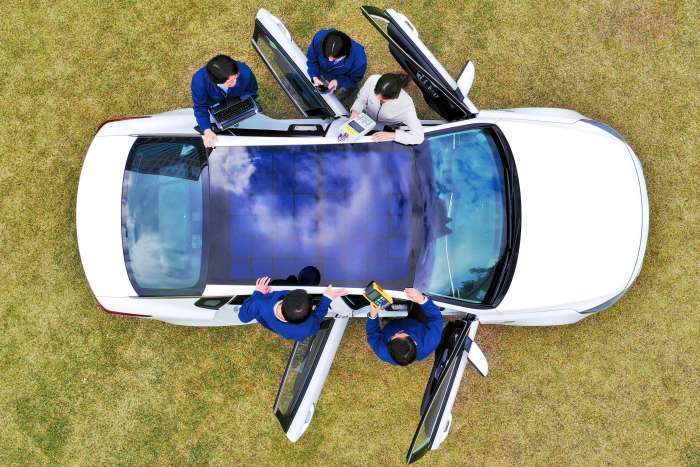During the late 1980s and into early 1990, I worked as an engineering student on solar-electric vehicles. This was not just theoretical work. Our team built an electric car with a solar-electric roof from scratch that ran. However, creating the car was not the true goal of the project. Rather, learning about solar-electric power generation, green energy, and green vehicles were our real goals. We built the vehicle and we learned the lessons. I earned a six-credit A- for my role on the nine-month project.
Our team members were taught by our professors and grad student proctors to challenge the very idea of solar-electric vehicles as valid. We were forced to answer difficult to research questions and prove the answers using repeatable methods or scientifically-validated sources.
Here are some of the questions we were taught to ask about solar roofs on green vehicles:
Q: “Does the solar roof capture a meaningful amount of power?”
Q: “Is the power that the solar roof provides affordable and of value? Or is the money better spent on other green initiatives and technologies?”
Q: “Does a solar roof pay back the carbon debt incurred to construct it?”
Q: “Does a solar roof diminish the best operation of the vehicle? In other words, is the solar roof heavy and thus a bad idea to mount at the very highest part of a thing that is made better by a lower center of gravity?”
 Solar Roofs Are Not About Real-World Benefits
Solar Roofs Are Not About Real-World Benefits
The bad news then, and the bad news now, is that the answer to all these questions make using solar panels on the roofs of cars a bad idea from an engineering perspective. One question we were never asked was if adding solar power to a vehicle might gain us a government tax credit that doesn't care how the green power is generated. Interestingly, Hyundai says that one of its main reasons for developing the solar roof now deployed on a limited basis on the Sonata was "...to help meet global regulations targets and improve vehicle fuel efficiency." Hyundai goes on to say, "Applying solar charging systems to internal combustion engine vehicles will contribute to the increase in vehicle exports, by enabling vehicles to adhere to global-scale environmental laws that regulate CO2 emissions."
 Solar Roofs Make Sense To Many Buyers
Solar Roofs Make Sense To Many Buyers
Frankly, we green vehicle fans don’t care why the solar roofs are coming. As a group, we like the idea. It is a frequent discussion point on pretty much every EV model’s Facebook fan club. Many fans like the way they look on a vehicle. Shouldn’t a desire to have one be enough? If gearheads can pretend that 710 hp sport utility vehicles in states with 55 MPH speed limits make any sense, putting a solar roof on a green vehicle as green jewelry or to help comply with emissions mandates is no more ridiculous.
Future Products: This New Tech Could Make A Solar Toyota Prius Practical
Hyundai's Solar Roof Goals
One easy thing to like about the Hyundai Sonata Hybrid’s solar roof is that its energy goal is realistic. Hyundai claims that the solar roof can add about two miles of EV range to the vehicle per day when parked in the sun. While two miles of range traveled without gas may not sound like much to folks uninterested in green vehicles, those of us who are advocates for green driving know that small gains in range add up. Two miles per day can equal about 500 solar/electric miles per year (factoring in rainy days). Expand the equation, and over the lifespan of this vehicle as many as 10,000 miles can be driven “powered by the sun.”
Is Solar Power Really "Free" or Carbon-Free?
The engineers among us know that those 10,000 miles are not really powered by the sun. Solar panel factories and their suppliers and shippers use carbon-rich power up the wazoo to create these little black boxes we all pretend produce "clean" energy. Add to that the sad reality that photovoltaic solar is not the most affordable way to generate low-carbon-footprint electric power (without subsidies). Another fact is that a solar roof is heavier and much more expensive than a dirt-cheap and lightweight stamped steel one. We don’t care. We want a solar roof the same way a pickup truck owner owner wants an aftermarket snorkel air intake or a Civic owner wants a fart-tube exhaust. The solar roof’s job is to make us happy. And it does that job.
John Goreham is a long-time New England Motor Press Association member and recovering engineer. John's focus areas are technology, safety, and green vehicles. In the 1990s, he was part of a team that built a solar-electric vehicle from scratch. For 20 years he applied his engineering and sales talents in the high tech world and published numerous articles in technical journals such as Chemical Processing Magazine. In 2008, he retired from that career to chase his dream of being an auto writer. In addition to Torque News, John's work has appeared in print in dozens of American newspapers and he provides reviews to many vehicle shopping sites. You can follow John on Twitter, and view his credentials at Linkedin
Hover mouse over image to see photo credits






Comments
I had not even thought about
Permalink
I had not even thought about the prospect of adding solar panels to a hybrid car. Realistically, it does provide at least as much benefit as mild hybrid systems do, effectively picking up otherwise unused power to make the vehicle more efficient. It is still a half-measure, and hard to cost justify without federal rebates. But like you say, there is good perceived value in the cool/green nature of a solar roof on a car, especially being a factory option, integrated with their battery/charging system.